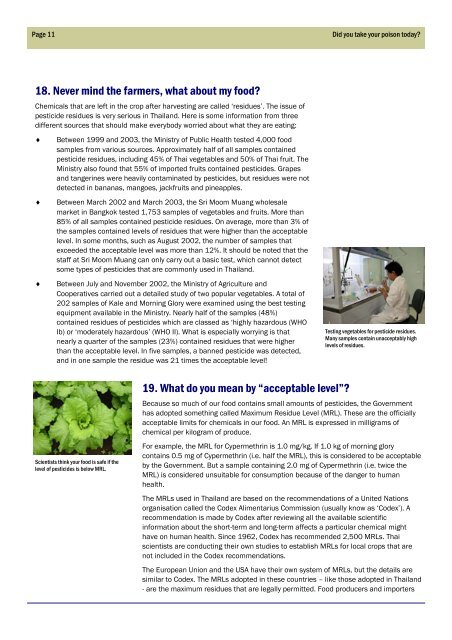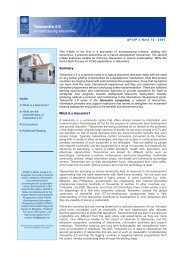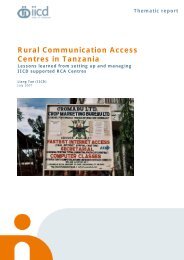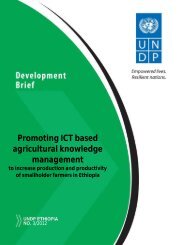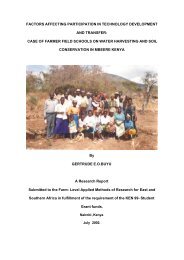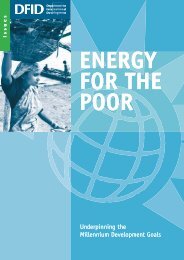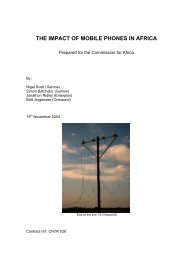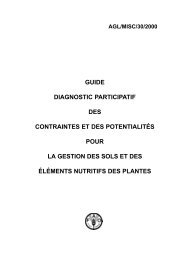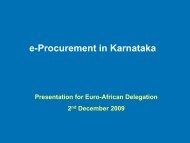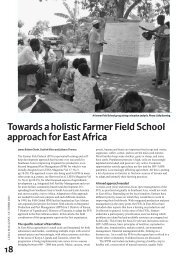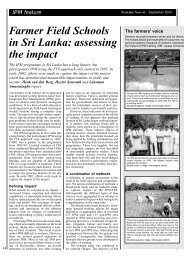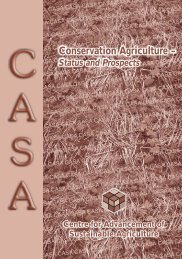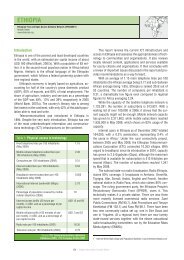Did you take your poison today? - Integrated Pest Management in ...
Did you take your poison today? - Integrated Pest Management in ...
Did you take your poison today? - Integrated Pest Management in ...
You also want an ePaper? Increase the reach of your titles
YUMPU automatically turns print PDFs into web optimized ePapers that Google loves.
Page 11<br />
<strong>Did</strong> <strong>you</strong> <strong>take</strong> <strong>you</strong>r <strong>poison</strong> <strong>today</strong>?<br />
18. Never m<strong>in</strong>d the farmers, what about my food?<br />
Chemicals that are left <strong>in</strong> the crop after harvest<strong>in</strong>g are called ‘residues’. The issue of<br />
pesticide residues is very serious <strong>in</strong> Thailand. Here is some <strong>in</strong>formation from three<br />
different sources that should make everybody worried about what they are eat<strong>in</strong>g:<br />
♦<br />
♦<br />
♦<br />
Between 1999 and 2003, the M<strong>in</strong>istry of Public Health tested 4,000 food<br />
samples from various sources. Approximately half of all samples conta<strong>in</strong>ed<br />
pesticide residues, <strong>in</strong>clud<strong>in</strong>g 45% of Thai vegetables and 50% of Thai fruit. The<br />
M<strong>in</strong>istry also found that 55% of imported fruits conta<strong>in</strong>ed pesticides. Grapes<br />
and tanger<strong>in</strong>es were heavily contam<strong>in</strong>ated by pesticides, but residues were not<br />
detected <strong>in</strong> bananas, mangoes, jackfruits and p<strong>in</strong>eapples.<br />
Between March 2002 and March 2003, the Sri Moom Muang wholesale<br />
market <strong>in</strong> Bangkok tested 1,753 samples of vegetables and fruits. More than<br />
85% of all samples conta<strong>in</strong>ed pesticide residues. On average, more than 3% of<br />
the samples conta<strong>in</strong>ed levels of residues that were higher than the acceptable<br />
level. In some months, such as August 2002, the number of samples that<br />
exceeded the acceptable level was more than 12%. It should be noted that the<br />
staff at Sri Moom Muang can only carry out a basic test, which cannot detect<br />
some types of pesticides that are commonly used <strong>in</strong> Thailand.<br />
Between July and November 2002, the M<strong>in</strong>istry of Agriculture and<br />
Cooperatives carried out a detailed study of two popular vegetables. A total of<br />
202 samples of Kale and Morn<strong>in</strong>g Glory were exam<strong>in</strong>ed us<strong>in</strong>g the best test<strong>in</strong>g<br />
equipment available <strong>in</strong> the M<strong>in</strong>istry. Nearly half of the samples (48%)<br />
conta<strong>in</strong>ed residues of pesticides which are classed as ‘highly hazardous (WHO<br />
Ib) or ‘moderately hazardous’ (WHO II). What is especially worry<strong>in</strong>g is that<br />
nearly a quarter of the samples (23%) conta<strong>in</strong>ed residues that were higher<br />
than the acceptable level. In five samples, a banned pesticide was detected,<br />
and <strong>in</strong> one sample the residue was 21 times the acceptable level!<br />
Test<strong>in</strong>g vegetables for pesticide residues.<br />
Many samples conta<strong>in</strong> unacceptably high<br />
levels of residues.<br />
Scientists th<strong>in</strong>k <strong>you</strong>r food is safe if the<br />
level of pesticides is below MRL.<br />
19. What do <strong>you</strong> mean by “acceptable level”?<br />
Because so much of our food conta<strong>in</strong>s small amounts of pesticides, the Government<br />
has adopted someth<strong>in</strong>g called Maximum Residue Level (MRL). These are the officially<br />
acceptable limits for chemicals <strong>in</strong> our food. An MRL is expressed <strong>in</strong> milligrams of<br />
chemical per kilogram of produce.<br />
For example, the MRL for Cypermethr<strong>in</strong> is 1.0 mg/kg. If 1.0 kg of morn<strong>in</strong>g glory<br />
conta<strong>in</strong>s 0.5 mg of Cypermethr<strong>in</strong> (i.e. half the MRL), this is considered to be acceptable<br />
by the Government. But a sample conta<strong>in</strong><strong>in</strong>g 2.0 mg of Cypermethr<strong>in</strong> (i.e. twice the<br />
MRL) is considered unsuitable for consumption because of the danger to human<br />
health.<br />
The MRLs used <strong>in</strong> Thailand are based on the recommendations of a United Nations<br />
organisation called the Codex Alimentarius Commission (usually know as ‘Codex’). A<br />
recommendation is made by Codex after review<strong>in</strong>g all the available scientific<br />
<strong>in</strong>formation about the short-term and long-term affects a particular chemical might<br />
have on human health. S<strong>in</strong>ce 1962, Codex has recommended 2,500 MRLs. Thai<br />
scientists are conduct<strong>in</strong>g their own studies to establish MRLs for local crops that are<br />
not <strong>in</strong>cluded <strong>in</strong> the Codex recommendations.<br />
The European Union and the USA have their own system of MRLs, but the details are<br />
similar to Codex. The MRLs adopted <strong>in</strong> these countries – like those adopted <strong>in</strong> Thailand<br />
- are the maximum residues that are legally permitted. Food producers and importers


